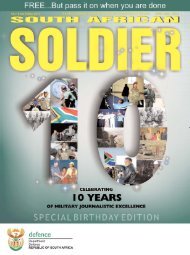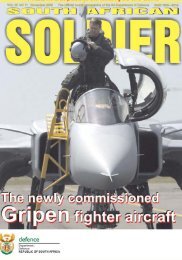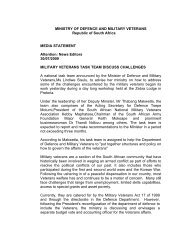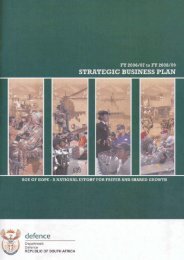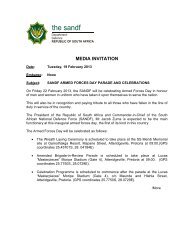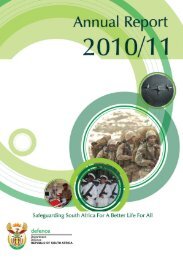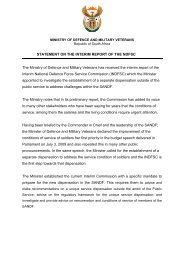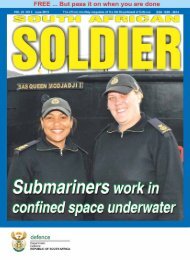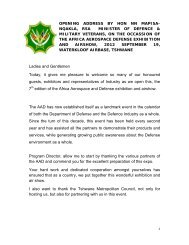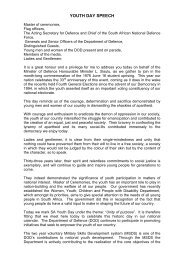Chapter 2 - P rogramme 1 - Department of Defence
Chapter 2 - P rogramme 1 - Department of Defence
Chapter 2 - P rogramme 1 - Department of Defence
You also want an ePaper? Increase the reach of your titles
YUMPU automatically turns print PDFs into web optimized ePapers that Google loves.
One <strong>of</strong> the major challenges that the Division had to<br />
face is the maintenance <strong>of</strong> facilities throughout the<br />
SANDF. While every effort was made to improve<br />
and ensure that NDPW was put in a position to<br />
assist the DOD in this regard, the expected results<br />
were, for various reasons, not forthcoming. Monthly<br />
meetings were conducted with NDPW <strong>of</strong>ficials<br />
to address the situation and to ensure that sound<br />
infrastructure project management was in place.<br />
The DOD is addressing this matter.<br />
Education, Training and Development<br />
A major achievement in the improvement <strong>of</strong><br />
employees was the promulgation <strong>of</strong> an instruction<br />
on apprenticeship in the DOD, which will make<br />
SANDF apprentice training compliant with the<br />
South African Qualifications Authority (SAQA)<br />
Act, 1995 (Act No. 58 <strong>of</strong> 1995) and will facilitate<br />
recruiting, as qualifications will be recognised and<br />
portable. This will greatly contribute towards the<br />
objectives <strong>of</strong> the Joint Initiative on Priority Skills<br />
Acquisition and the Accelerated and Shared Growth<br />
Initiative (ASGISA). The formalisation <strong>of</strong> a good<br />
relationship with the Engineering Council <strong>of</strong> South<br />
Africa (ECSA) is progressing well. This will enable<br />
the SANDF to attain the ECSA registration for its<br />
technical engineering personnel.<br />
Ammunition Disposal<br />
As part <strong>of</strong> the SANDF’s ammunition risk reduction<br />
effort, the over-and-above functions <strong>of</strong> the<br />
demolition <strong>of</strong> ammunition, ammunition handling<br />
and firebreak capabilities were enhanced. The<br />
ammunition disposal capability had been improved<br />
and was expanded. The De Aar ammunition<br />
demolition range was requalified to conduct disposal<br />
through open demolition and was also the last <strong>of</strong><br />
the planned requalifications. A total <strong>of</strong> 1 500 tons<br />
<strong>of</strong> dangerous ammunition have been identified for<br />
further mass disposal through open demolition.<br />
In Africa, support was readily provided to countries<br />
that required logistic expertise in ammunition<br />
disposal. As requested by the Government <strong>of</strong><br />
Mozambique, 1 213 tons <strong>of</strong> unexploded dangerous<br />
ammunition was demolished in Maputo, after the<br />
massive explosion in an ammunition storage area.<br />
It took over 56 tons <strong>of</strong> serviceable explosives to<br />
carry out the task safely. A request was also received<br />
from the Government <strong>of</strong> Uganda to assist in the<br />
destruction <strong>of</strong> 460 tons <strong>of</strong> ammunition, <strong>of</strong> which<br />
| <strong>Department</strong> <strong>of</strong> <strong>Defence</strong> |<br />
only 280 tons <strong>of</strong> old ammunition was destroyed.<br />
The full need could not be met due to insufficient<br />
serviceable explosives to undertake the disposal, as<br />
well as a lack <strong>of</strong> the continued sponsorship from the<br />
non-governmental organisation engaged in the task.<br />
International recognition <strong>of</strong> SANDF capability<br />
and expertise was evident as a member <strong>of</strong> the<br />
Logistics Division was requested to present a paper<br />
on the disposal <strong>of</strong> ammunition at the International<br />
Disposal Conference in Argentina.<br />
Social Responsibility<br />
Within the country, a poverty relief initiative was<br />
undertaken, with a further partnership between the<br />
SANDF and the Working for Water P<strong>rogramme</strong> <strong>of</strong><br />
the <strong>Department</strong> <strong>of</strong> Water Affairs and Forestry, to<br />
utilise military veterans to eradicate alien and invasive<br />
vegetation on <strong>Defence</strong> Force-controlled properties.<br />
This effort was named Operation VUSELELA and<br />
has been extremely successful. Using the relatively<br />
small sum <strong>of</strong> Rm14, a total <strong>of</strong> 5 000 hectares <strong>of</strong><br />
invasive vegetation had been eradicated.<br />
The Division has, in support <strong>of</strong> the Government’s<br />
goal <strong>of</strong> sustainable utilisation <strong>of</strong> natural resources,<br />
embarked upon an Energy Efficiency Campaign in<br />
order to reduce the demand for electricity through<br />
participating in the National Energy Response Team<br />
<strong>of</strong> the <strong>Department</strong> <strong>of</strong> Minerals and Energy. Over<br />
and above this, the Division has also been partnering<br />
in various Government initiatives on renewable<br />
energy such as biodiesel, wind and solar energy.<br />
A cooperative governance initiative was undertaken<br />
to assist the Gauteng Provincial Government in<br />
its Dinokeng Blue IQ Project to aid in the socioeconomic<br />
development <strong>of</strong> the Dinokeng region.<br />
The SANDF’s role in this project was to provide<br />
a part <strong>of</strong> Ditholo Training Area for co-use in the<br />
establishment <strong>of</strong> the Dinokeng Game Reserve. The<br />
SANDF has in the process donated game with an<br />
estimated value <strong>of</strong> Rm1,7 to the project and will<br />
further enter into a co-use agreement in order to<br />
contribute to the management <strong>of</strong> the Dinokeng<br />
Game Reserve.<br />
A number <strong>of</strong> other cooperative governance initiatives<br />
have been initiated with local government in the<br />
Gauteng Province through the establishment <strong>of</strong><br />
cooperation agreements for addressing biodiversity<br />
and sustainability issues on <strong>Defence</strong>-controlled<br />
areas. Amongst others are the Eeufees and Swartkop<br />
Park training areas in Pretoria.<br />
163 Annual Report FY 2007 - 2008<br />
| <strong>Chapter</strong> 9 - P<strong>rogramme</strong> 7: Joint Support |



